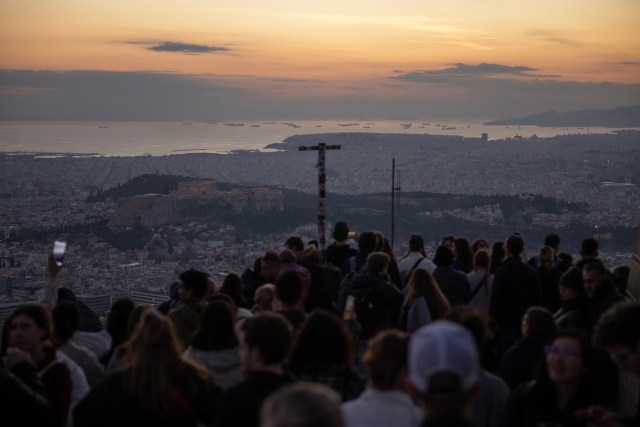I was born in a neighbourhood of Athens that separates Kolonaki, an area frequented by politicians and celebrities, from Exarchia, a district favoured by rebels, intellectuals and artists. The location probably helped turn me into a journalist: caught between sides, seeking answers.
I returned to the Greek capital as a Reuters correspondent in 2007, on the eve of a decade-long debt crisis. I covered riots, anti-austerity protests, bailout negotiations and repeated elections. The country’s struggle for change marked that period and contributed to an Athens’ makeover.

In the heart of the city, shops that shut during the debt crisis are now hip cafes, retro-style bars and gourmet restaurants. Boutique hotels and rooftop bars have popped up below the Acropolis and along the pedestrianised Ermou, one of the capital’s busiest shopping streets.
A real estate boom is also reviving areas outside the main centre. The Kypseli neighbourhood has become a youth hotspot, while Pangrati, near the Presidential Mansion, is teeming with brunch cafes.
When visitors ask for my recommendations, here’s what I tell them:

Trending: Vibrant, with attractions that range from the ancient Byzantine to the modern, Athens is an increasingly popular destination for both vacationers on a city break and businesspeople.
I like to visit the Benaki Museum of Greek Culture and Museum of Cycladic Artum of Cycladic Art near the National Garden for a journey through Greece’s diverse cultures. The nearby renovated National Gallery that houses modern Greek art is a must-see; buying tickets online can save you from a long queue.
When I need to clear my mind, I often walk to the top of Lycabettus Hill, which offers the best view of the city. If time allows, I recommend taking the cable car to the top and walking down the forest path.

Hot ticket: A summer night performance at the stunning open-air Odeon of Herod Atticus on the southern slopes of the Acropolis hill is a special experience. Greece’s most renowned artists, including late opera diva Maria Callas, have performed in the ancient stone venue. Performances at this theatre and other venues feature in the Athens Epidaurus Festival, one of the oldest in Europe, which runs from May to October and offers events from opera performances to rock concerts. Tickets are available online but you need to book early as most performances sell out quickly.
If you fancy a movie with the chirp of cicadas in the background, try one of Athens’ dozens of outdoor cinemas. They are a ritual for Greeks and movies are subtitled. In winter, head south to the Stavros Niarchos Foundation Cultural Centre for an evening performance at the National Opera.

Old favourites: For a closer view of the Parthenon, trek up the hill or take the pedestrianised D. Areopagitou Street to the modern Acropolis Museum, which hosts the famed sculptures that once adorned the temple – whatever Lord Elgin left behind plus replicas of the ones that are in the British Museum in London. From the top floor, through the window, you can marvel at the temple. To avoid soaring temperatures, I prefer to visit the Acropolis early in the morning or in the evening. A stone’s throw away from the classical temples, the ancient city’s oldest neighbourhood, Plaka, boasts a plethora of cafes, tavernas and souvenir shοps with local products such as olive oil, which sells for around 10 euros ($10) a litre.
To buy: Plaka is also rich in shops with items made by local artists, including pottery and ancient Greek-style leather sandals, which have become popular but are sold at reasonable prices. Locals visit antique shops in the area for treasure-hunting that includes second-hand vinyl records. Greek designers have also made a splash over the past years and fashionable items include Lia Manjorou’s Ames bags, decorated with the ancient Greek meander pattern, and the linen embroidered resort wear of Greek Archaic Kori.

Definitive food item: Souvlaki – grilled beef or pork meat on a stick or wrapped in flatbread with salad and garlic yogurt – is Greece’s signature snack. Long seen as an inexpensive treat, souvlaki has not escaped the impact of inflation but still goes for 2.5 to 4 euros. Locals love the souvlaki at Kapsa, a recent addition on Skouleniou Street, Volvi at the central meat market, or Kostas near Syntagma Square. As people queue for a bite, the owner’s mantra, printed on a sign, is “No stress”.
Getting away: To escape the pressure and the noise of the city centre, I head to a waterfront cafe at the Athens Riviera or take a swim at one of the beaches on the way to Cape Sounio. If you fancy a longer excursion, take a ferry from the port of Piraeus to the island of Aegina, famous for its pistachios.
Annoyances: Sidewalks. They don’t always exist and when they do, they are often broken, slippery or occupied by parked cars. Pushing a pram or a wheelchair can be a real struggle in Athens.

DATA POINTS
Price of ice cream scoop: 3.70 euros ($3.85) with waffle cone at Le Greche, on Mitropoleos Street. Price of cup of coffee: 2.30 euros ($2.40) for cappuccino, 2.50 ($2.60) for Freddo espresso (iced coffee) at Brigante cafe, near Syntagma Square. Great place to see a sunset: Lycabettus Hill, a panoramic vista of Athens with views that stretch as far as the port of Piraeus and the Saronic Gulf. Biggest university: National and Kapodistrian University of Athens, with more than 100,000 students. (Renee Maltezou/Reuters)








You must be logged in to post a comment.